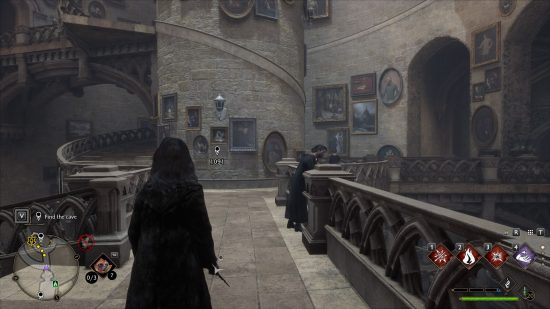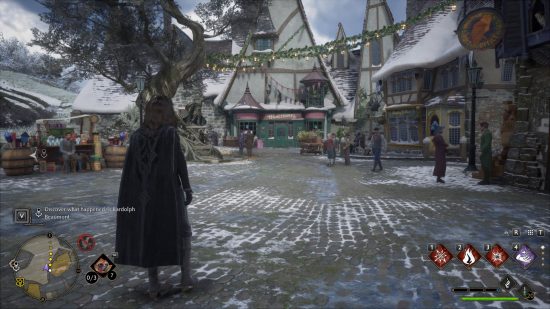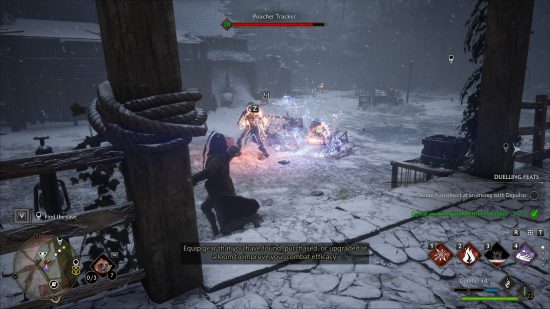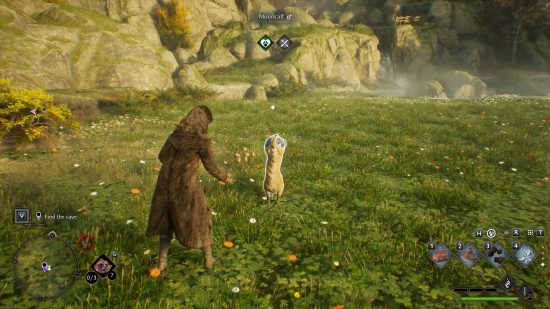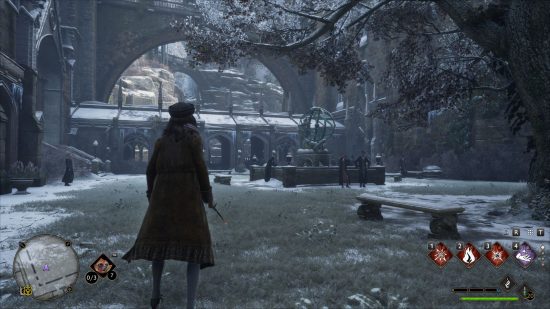Our Verdict
Content-rich and competent, if a little uninspired, Potter fans will enjoy Hogwarts Legacy's faithful recreation of its universe, but it brings little of novelty to the open-world RPG genre.
If you like Harry Potter, you’ll probably like the first hour of Hogwarts Legacy. Larger-than-life characters, a mysterious portkey, an enormous dragon, and a spontaneous visit to Gringotts, all followed by the Sorting Hat ceremony – a lengthy tutorial that sets out the game’s stall as a vehicle for Potterhead wish fulfilment.
However, take the Harry Potter licence away and open-world RPGs are everywhere. Bloated open-world RPGs with too little meaningful content are especially common. So Hogwarts Legacy faces the challenge of standing apart in a crowded genre in which too many entrants are already content to half-arse things.
After the intro sequence, the authenticity of Hogwarts is immediately on show. From familiar locations within the school such as the Great Hall and the Grand Staircase to lesser-seen areas like the Ravenclaw and Hufflepuff common rooms, a lot of TLC has gone into making Hogwarts look exactly as fans would want. As you arrive as a fifth-year student – one of very few to have the privilege, as the story soon explains – ensuring the world around you feels lived in is vital. Small details such as a Chudley Cannons poster on the wall of a common room, or scorch marks on a corridor wall indicating the “first known instance of someone casting Bombarda”, enhance this.
While there is a whole world around Hogwarts to explore, you can spend hours exploring the school itself, because it holds plenty of mysteries and puzzles to solve. Many are locked away from you until you reach the required point in the story – or in the case of the door number puzzles, once you find the instructions lying around – and they all do the job of making Hogwarts feel magical and full of wonder.
Outside the school grounds, the main landmark is Hogsmeade – a small village full of shops where budding witches and wizards can acquire brooms, butterbeer, and all manner of combat-focused items. Hogwarts Legacy’s interpretation of this high street takes more liberties with previous depictions than its painstaking recreation of the school itself, but fans will still enjoy hanging out in Honeydukes, Ollivander’s, the Hog’s Head, and so on.
The rest of the world is mostly uncharted territory. The Forbidden Forest is full of centaurs and spiders as you’d expect, but beyond that, you’ll find hostile goblins, poachers, bandits, and Hogwarts Legacy beasts loitering around camps and dilapidated ruins, and the odd hamlet containing friendly folk too. While relying on a map full of icons is impossible within Hogwarts – the countless floors and overlapping areas make even fast travelling a fiddly affair – you can explore the world beyond by broomstick, ticking off map icons such as Infamous Foes and Ancient Magic Hotspots.
Many Hogwarts Legacy characters will join you during the game, and each of them is exactly what you’d expect; over the top, enthusiastic, and with strong personalities, whether you love or hate them. Characters in this universe have always been extravagant, so the almost cartoonish rendering of the Hogwarts Legacy cast rings true.
Cracks begin to show, however, when you look past the ‘Potterishness’ of it all and consider Hogwarts Legacy as a game. While the characters themselves are interesting, side quests are often just simple fetch jobs, with a few enemies to slay on the way. The Witcher 3 was educating the industry on how to write a good side quest almost eight years ago. Here, they just fall back to the same cookie-cutter quest designs we’ve seen many times before.
You’ll have plenty of choices in dialogue, most of which give added context or allow you to enquire about a character’s backstory. But there are some that allow you to essentially be a selfish person, like retrieving someone’s lost belongings and then refusing to give them back afterwards. Apart from a disappointed response in the moment and the occasional callback in a future conversation, however, this has no long-term bearing whatsoever on how you’re perceived; there’s no morality or reputation system in the game.
Indeed, role-playing in general is limited. Being a student, you’d expect classes to be a huge part of your day-to-day life, but you could easily go days without having to attend one because you’re prioritising other missions. When you do eventually turn up, after the first lesson for each class, subsequent lessons are nothing more than cutscenes, with short dialogue interactions at the end. I didn’t really feel much like a student.
When classes aren’t on, everybody in the school also seems to vanish – you’d think they’re sleeping, but you can waltz in and out of dorm rooms with empty beds and not find a single soul. Portkey Games clearly understands how important attention to detail is when creating that Potterish feel, so it’s surprising to see this kind of thing overlooked when it’s so crucial to making the people around you feel real – most other open-world games ensure named characters have proper schedules, a la Watch Dogs Legion, Cyberpunk 2077, or even Skyrim.
At least you have plenty of upgrades and customisation options. You can find gear in chests or as drops from slain enemies, and every level up earns you a point to spend on talents, which are essentially perks. You can also learn spells, via both the main story and side quests, but there’s no real challenge to ‘learning’ them – point the cursor on-screen in the direction indicated, and press the corresponding button as it passes by, like a rhythm minigame without any music. Once you’ve done that for the first time, you can use that spell as and when you like – no need to practise it.
Talents do allow you to upgrade certain Hogwarts Legacy spells – for example, Incendio, the first fire spell you learn, can be upgraded to cast a ring of fire around you instead of just a short-range blast in front. But would it not have been better to slowly increase your aptitude with each spell as you use it, much like how students are required to practise their spells in the books and films?
It may be a symptom of its era – 1890s Britain – but it’s also impossible to look cool in Hogwarts Legacy. Outside of a couple of bits of clothing – the legendary cape is badass – most attire looks dull or outrageously bad, such as the dragon-eyed spectacles. Since your fellow students are permanently kitted out in just their house robes too, rocking up to class in ‘smithing attire’ or an ‘authentic historian’s uniform’ looks ridiculous. Not to mention if your character has long hair, it’ll clip through any neckwear you equip.
Combat is perhaps where Hogwarts Legacy shines most. Only being able to equip four spells at once (though you can navigate through spell ‘sets’ for a total of 16 without having to go into a menu, once you’ve bought them with talent points) is a frustrating limitation spurred by console development, I suspect, but when you get used to which spells are assigned to which keys, you can pull off some nifty combos and juggle enemies like you’re in a fighting game.
You’ll face a variety of enemies, each with their own weaknesses, and since spells are colour coded – yellow for control, purple for force, red for damage, and green for unforgivable curses – it’s easy to know the best spells for the challenge at hand. Especially when some enemies can only be damaged by a specific type of spell, indicated by a coloured forcefield around them. It’s very fluid, like Arkham-style combat from range rather than getting up close and personal.
Alongside your spells, you also have items to use in combat – mainly potions and plants, which you learn about in Potions and Herbology classes. For some completely baffling reason though, you have to wait a variable amount of time for them to brew or grow. It’s only 15 seconds for a simple health potion, but as you have to do them one at a time, it all adds up to make a full restock excruciatingly slow. It feels like a wildly unnecessary free-to-play mobile game mechanic shoehorned into this single-player RPG.
When you need a break from the fighting, you can participate in Summoner’s Court matches – a minigame somewhat like curling, but with the Accio spell – or beat time trials on your broom. And while there’s no Quidditch in Hogwarts Legacy – there’s the distinct whiff of DLC here, as the stadium exists and characters reference it quite often – there’s plenty of other flying to be done. You can also go to a den and catch one of the many beasts for your vivarium in the Room of Requirement – which provides crafting resources for upgrades as long as you feed and nurture them – or you can spend time customising the room with plenty of decorations picked up via collection chests. Or you can partake in Merlin Trials, which are essentially puzzles to solve with one of your many spells. An in-game card game like Gwent (The Witcher 3) or Genius Invokation (Genshin Impact) feels like a huge miss here, especially given the in-lore existence of Exploding Snap or Gobstones, but there’s still plenty to do beyond ticking off map icons.
Performance-wise, there’s a little to be desired. I’m playing on a 3080 with the graphics preset on ultra, and while quieter areas can see me hit 80fps, wandering around a busy part of Hogwarts or waltzing from shop to shop in Hogsmeade can drop to around 40fps. One particularly egregious occasion was at the Owlery, where I spent my entire time below 20fps, but it fixed itself after leaving. It’s not unplayable, and even without ray tracing the game looks rather lovely, but there’s room for improvement.
Hogwarts Legacy starts constrained, but the further you progress, the more it opens up. The world around Hogwarts feels quite Fable-esque, while the gear and inventory system is very similar to Destiny 2. Meanwhile, interacting with other characters and ticking things off the map works as it did in Assassin’s Creed Valhalla.
All of these are great games and by cribbing from them Hogwarts Legacy has taken the safe route to offer a capable open-world RPG. But without something more original going for it, it struggles to develop an identity of its own. That’ll be bothersome for anyone who isn’t an existing Potter fan.
The creator of the Harry Potter series, JK Rowling, has made a number of transphobic remarks on social media in recent years. Warner Bros. has the licence to make games based on Harry Potter. While the details of that deal aren’t publicly known, and WB Games says “J.K. Rowling is not directly involved in the creation of the game”, it is likely that, as the creator and owner of the Harry Potter IP, she will earn royalties from its sales. If you’d like to learn more about transgender equality or lend your support, here are two important charities we encourage you to check out: the National Center for Transgender Equality in the US, and Mermaids in the UK.

